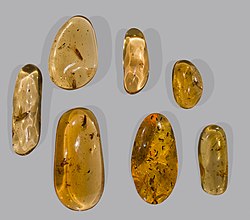
Back بوابة:علم الأحياء القديمة Arabic Portal:Paleontologia Catalan Portail:Paléontologie French Portale:Paleontologia Italian Portal:Paleontology Malay Portaal:Paleontologie Dutch Portal:Paleontologia Polish Portal:Paleontologia Portuguese Портал:Палеонтология Russian Портал:Палеонтология Tatar
|
The Palaeontology Portal
Introduction Paleontology (/ˌpeɪliɒnˈtɒlədʒi, ˌpæli-, -ən-/ PAY-lee-on-TOL-ə-jee, PAL-ee-, -ən-), also spelled palaeontology or palæontology, is the scientific study of life that existed prior to the start of the Holocene epoch (roughly 11,700 years before present). It includes the study of fossils to classify organisms and study their interactions with each other and their environments (their paleoecology). Paleontological observations have been documented as far back as the 5th century BC. The science became established in the 18th century as a result of Georges Cuvier's work on comparative anatomy, and developed rapidly in the 19th century. The term has been used since 1822 formed from Greek παλαιός ('palaios', "old, ancient"), ὄν ('on', (gen. 'ontos'), "being, creature"), and λόγος ('logos', "speech, thought, study"). Paleontology lies on the border between biology and geology, but it differs from archaeology in that it excludes the study of anatomically modern humans. It now uses techniques drawn from a wide range of sciences, including biochemistry, mathematics, and engineering. Use of all these techniques has enabled paleontologists to discover much of the evolutionary history of life, almost back to when Earth became capable of supporting life, nearly 4 billion years ago. As knowledge has increased, paleontology has developed specialised sub-divisions, some of which focus on different types of fossil organisms while others study ecology and environmental history, such as ancient climates. (Full article...) Selected article on the prehistoric world and its legacies
Diplodocus (meaning 'double bar') is a genus of diplodocid sauropod dinosaur whose fossilised skeleton was first discovered in 1878. The generic name refers to its double-beamed chevron bones (Greek diplos/διπλος meaning 'double' and dokos/δοκος meaning 'wooden beam' or 'bar') located in the underside of the tail. They were initially believed to be unique to Diplodocus; however, they have since then been discovered in other diplodocids.
It lived in what is now western North America at the end of the Jurassic Period. Diplodocus was one of the more common dinosaurs found in the Upper Morrison Formation, about 150 to 147 million years ago, in what is now termed the Kimmeridgian and Tithonian stages. This was an environment and time dominated by gigantic sauropod dinosaurs such as Camarasaurus, Barosaurus, Apatosaurus and Brachiosaurus. Diplodocus is among the most easily identifiable dinosaurs, with its classic dinosaur shape, long neck and tail and four sturdy legs. For many years, it was the longest dinosaur known. Its great size may have been a deterrent to the predators Allosaurus and Ceratosaurus: their remains have been found in the same strata, which suggests they coexisted with Diplodocus. (see more...) Did you know?

General images -The following are images from various paleontology-related articles on Wikipedia.
Selected article on paleontology in human science, culture and economicsBone Sharps, Cowboys, and Thunder Lizards is a graphic novel written by Jim Ottaviani and illustrated by the company Big Time Attic. The book tells a slightly fictionalized account of the Bone Wars, a period of intense excavation, speculation, and rivalry which led to a greater understanding of dinosaurs in the western United States. This novel is the first semi-fictional work written by Ottaviani; previously, he had taken no creative license with the characters he depicted, portraying them strictly according to historical sources. Bone Sharps follows the two scientists Edward Drinker Cope and Othniel Marsh as they engage in an intense rivalry for prestige. Ottaviani has Cope and Marsh interact and meet many important figures of the Gilded Age, from P. T. Barnum to U.S. Grant, as the two scientists pursue their hotheaded and sometimes illegal acquisitions of fossils. Unlike in his previous books, "the scientists are the bad guys this time". Upon release, the novel received praise from critics for its exceptional historical content, although some reviewers wished more fiction had been woven into the story. (see more...) On this day...
Selected image
CategoriesTopicsGeneral - Paleontology - Fossil - Evolution - Extinction Quality ContentFeatured paleontology articles
- Achelousaurus
- Acrocanthosaurus
- Albertosaurus
- Allosaurus
- Amargasaurus
- Ankylosaurus
- Apatosaurus
- Archaeopteryx
- Baryonyx
- Carnotaurus
- Catopsbaatar
- Ceratosaurus
- Chicxulub Crater
- Compsognathus
- Cretaceous–Tertiary extinction event
- Daspletosaurus
- Deinocheirus
- Deinonychus
- Deinosuchus
- Dilophosaurus
- Dinosaur
- Diplodocus
- Dromaeosauroides
- Edmontosaurus
- Elasmosaurus
- Giganotosaurus
- Gorgosaurus
- Herrerasaurus
- Iguanodon
- Istiodactylus
- Lambeosaurus
- List of dinosaur genera
- Majungasaurus
- Massospondylus
- Megalodon
- Nemegtomaia
- Nigersaurus
- Opisthocoelicaudia
- Paranthodon
- Parasaurolophus
- Plateosaurus
- Psittacosaurus
- Seorsumuscardinus
- Spinosaurus
- Stegosaurus
- Stegoceras
- Styracosaurus
- Tarbosaurus
- Thescelosaurus
- Triceratops
- Tyrannosaurus
- Velociraptor
Things you can doCurrent Paleontology FACs - None yet... WikiProjectsRelated portalsAssociated WikimediaThe following Wikimedia Foundation sister projects provide more on this subject:
Discover Wikipedia using portals |
© MMXXIII Rich X Search. We shall prevail. All rights reserved. Rich X Search








































